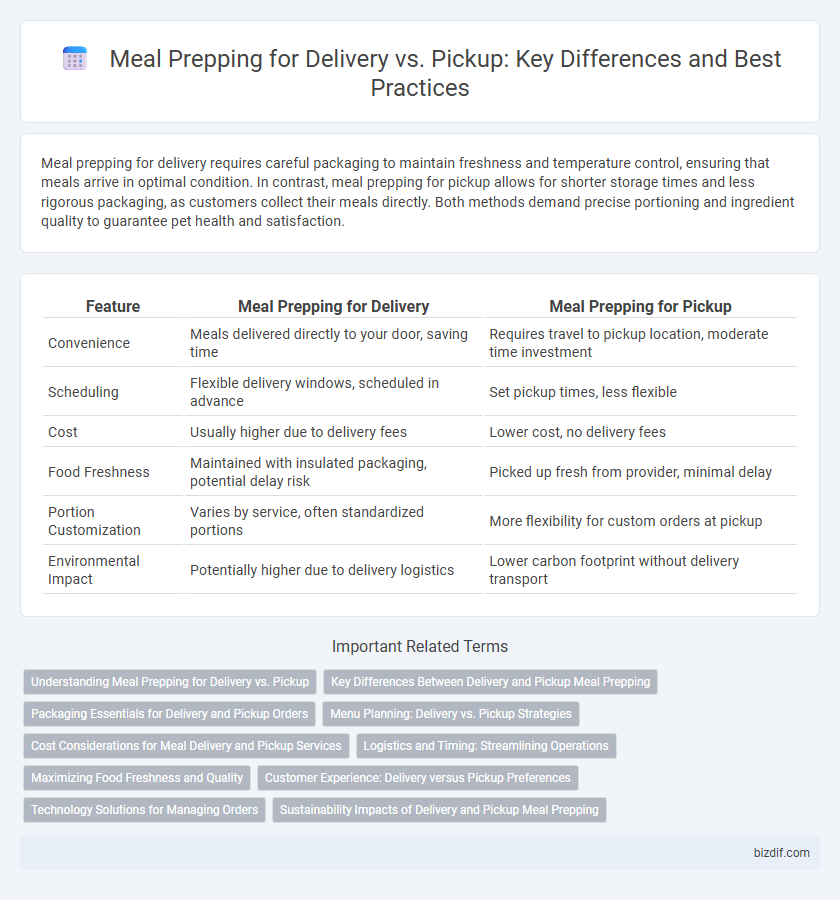Meal prepping for delivery requires careful packaging to maintain freshness and temperature control, ensuring that meals arrive in optimal condition. In contrast, meal prepping for pickup allows for shorter storage times and less rigorous packaging, as customers collect their meals directly. Both methods demand precise portioning and ingredient quality to guarantee pet health and satisfaction.
Table of Comparison
| Feature | Meal Prepping for Delivery | Meal Prepping for Pickup |
|---|---|---|
| Convenience | Meals delivered directly to your door, saving time | Requires travel to pickup location, moderate time investment |
| Scheduling | Flexible delivery windows, scheduled in advance | Set pickup times, less flexible |
| Cost | Usually higher due to delivery fees | Lower cost, no delivery fees |
| Food Freshness | Maintained with insulated packaging, potential delay risk | Picked up fresh from provider, minimal delay |
| Portion Customization | Varies by service, often standardized portions | More flexibility for custom orders at pickup |
| Environmental Impact | Potentially higher due to delivery logistics | Lower carbon footprint without delivery transport |
Understanding Meal Prepping for Delivery vs. Pickup
Meal prepping for delivery requires packaging meals to maintain freshness and temperature during transit, often involving insulated containers and proper sealing to prevent spills. In contrast, meal prepping for pickup prioritizes convenience and quick handoff, allowing for less emphasis on extended preservation methods. Understanding these differences ensures optimal meal quality and customer satisfaction in both delivery and pickup scenarios.
Key Differences Between Delivery and Pickup Meal Prepping
Meal prepping for delivery offers convenience by eliminating the need to travel, often including insulated packaging to maintain freshness and temperature during transit. In contrast, meal prepping for pickup requires customers to collect their orders within a designated time window, ensuring meals are freshly prepared and ready upon arrival, but demands more precise timing and customer availability. Delivery typically incurs additional fees and longer wait times, whereas pickup can provide cost savings and immediate meal retrieval.
Packaging Essentials for Delivery and Pickup Orders
Effective packaging essentials for meal prepping delivery involve using insulated containers and tamper-evident seals to maintain temperature and freshness during transit. For pickup orders, packaging prioritizes convenience and durability with stackable, leak-proof containers and easy-open lids to ensure meals remain intact and presentable. Both methods require clear labeling with reheating instructions and allergen information to enhance customer satisfaction and safety.
Menu Planning: Delivery vs. Pickup Strategies
Menu planning for meal prepping delivery requires prioritizing packaging durability and maintaining optimal temperature to ensure food quality during transit, while pickup-oriented menus emphasize ingredient freshness and quick assembly to facilitate immediate customer handoff. Delivery strategies often incorporate meals designed to withstand longer hold times without compromising texture or flavor, whereas pickup menus can include more perishable items and complex components that benefit from last-minute preparation. Tailoring recipes and portion sizes according to the logistical demands of delivery or pickup enhances customer satisfaction and operational efficiency.
Cost Considerations for Meal Delivery and Pickup Services
Meal prepping for delivery typically incurs higher costs due to added fees such as shipping, packaging, and fuel surcharges compared to pickup options. Pickup services generally offer lower prices as they eliminate delivery expenses and often provide discounts for in-store collection. Evaluating cost differences between delivery and pickup meal prep services can help consumers optimize budget efficiency while maintaining meal quality and convenience.
Logistics and Timing: Streamlining Operations
Meal prepping for delivery requires precise coordination of packaging, route planning, and temperature control to maintain food quality throughout transit, optimizing delivery times and reducing spoilage. In contrast, meal prepping for pickup emphasizes efficient order batching and timing synchronization to minimize customer wait times and ensure fresh meals upon arrival. Both methods benefit from integrated inventory management and real-time tracking systems to streamline operations and enhance overall efficiency.
Maximizing Food Freshness and Quality
Meal prepping for delivery requires insulated packaging and temperature control to preserve food freshness during transit, reducing the risk of spoilage. Meal prepping for pickup allows for immediate handoff, maintaining optimal texture and flavor by minimizing time between preparation and consumption. Both methods depend on proper container sealing and portioning to maximize quality and customer satisfaction.
Customer Experience: Delivery versus Pickup Preferences
Meal prepping for delivery offers convenience by saving customers time and effort, enhancing satisfaction with doorstep arrival and reducing the need for travel. Pickup meal prepping appeals to customers who prefer immediate control over timing and freshness, often valuing direct interaction and personal schedule flexibility. Understanding customer preferences for delivery versus pickup helps optimize meal prep services, tailoring experiences to meet demand for either speed or customization.
Technology Solutions for Managing Orders
Technology solutions for managing orders in meal prepping delivery include integrated mobile apps and GPS tracking systems that enhance route optimization and real-time delivery updates. For meal prepping pickup, online ordering platforms with seamless payment gateways and customizable scheduling interfaces streamline customer experience and reduce wait times. Both methods benefit from automated inventory management and AI-driven demand forecasting to optimize meal preparation efficiency.
Sustainability Impacts of Delivery and Pickup Meal Prepping
Meal prepping for pickup significantly reduces carbon emissions compared to delivery by eliminating last-mile transportation and minimizing packaging waste. Delivery meal prepping often relies on single-use containers and generates higher fuel consumption due to decentralized distribution routes. Optimizing meal prep operations for pickup not only lowers the environmental footprint but also encourages consumer habits that support sustainable food systems.
Meal prepping for delivery vs meal prepping for pickup Infographic

 bizdif.com
bizdif.com